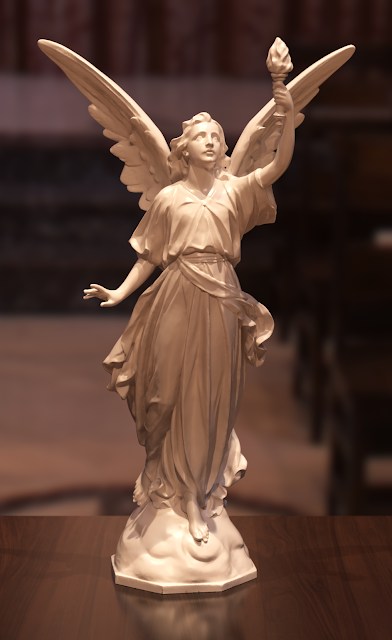I recently made some significant improvements and additions to Photorealizer's subsurface scattering (SSS) capabilities. In particular, I implemented the following:
• separate scattering coefficients for R, G, and B channels (for both path-traced and diffusion-based SSS)
• the
Better Dipole model (for more accurate diffusion-based SSS)
• basic single scattering (for use with diffusion-based SSS)
• several bug fixes (for diffusion-based SSS)
Below are some new Photorealizer renders showing off the new features. Click the images to view them at full size and do back-to-back comparisons. The strong transfer curve I've applied might slightly exaggerate the differences between the path tracing and diffusion versions.
 |
| Path tracing. |
 |
| Diffusion-based multiple scattering plus single scattering. |
 |
| Diffusion-based multiple scattering only. |
 |
| Diffuse BRDF approximation to multiple scattering. |
 |
| Diffuse BRDF approximation plus single scattering. |
 |
| Single scattering only. |
 |
| No transmission at all. |
Miscellaneous Details
Below are some miscellaneous details about my SSS systems.
My Monte Carlo path tracing SSS system is unbiased and physically-based. I use the Henyey–Greenstein phase function for anisotropic scattering. I currently support only homogeneous media, although I could use unbiased distance sampling (which I
implemented in my sky renderer) for heterogenous media. In the updated system, when the R, G, and B scattering coefficients differ from one another I trace separate rays for the separate channels.
As I've described in previous posts, my diffusion-based SSS system uses a precomputed, hierarchical point cloud of irradiance samples. The system works with multiple objects and even instancing—I create a separate point cloud for each object that is marked for diffusion-based multiple scattering.
To compute the albedo for the diffuse BRDF approximation for the Better Dipole model, I used numerical quadrature, rather than trying to do analytical integration. This only needs to be done once for each material, so it has no noticeable impact render times.
Several of the resources that I've been using for diffusion-based SSS have lots of ambiguities and some errors. By cross-referencing various sources and closely examining the derivations of the models, I was able to identify several things that needed to be fixed in my implementation. I did some relatively extensive testing, and I believe that all of the major pieces of my implementation are now correct. As a result, my renders are now much more physically-accurate.
My diffusion and path tracing renders still don't match perfectly due to the limitations and inaccuracies of the dipole diffusion approximation. The dipole diffusion approximation assumes that the object is a semi-infinite, homogeneous slab, and does not handle thin or curvy geometry well. In the model, light is forced to a depth of one mean free path before scattering, which is especially inaccurate near the source, blurring away fine details and causing low albedo colors to be absorbed too much. Some light goes all the way through the object, and this is not handled properly. Further inaccuracies are inevitable due to other assumptions that the model makes and approximations made in the derivation. Path tracing is still the best option when you want the most accurate results—it captures all of the subtleties automatically, and the resulting images have noticeably more depth.
Test Renders
Below are some test renders. The scene is a top-down view of a large slab of material. The material scatters and absorbs all wavelengths equally. There is a magenta environment map surrounding the scene (which is why the material looks magenta). In the upper right, there is a green spherical emitter. The black line is a thin wall that prevents light from the sphere from passing to the other side except by way of SSS. In other words, all of the green to the right of the wall is a result of subsurface scattering.
First 4 images:
Relative IOR: 1.62
Phase function: isotropic
Single-scattering albedo: 0.999
 |
| Path tracing. |
 |
| Diffusion-based multiple scattering plus single scattering. |
 |
| Diffusion-based multiple scattering only. |
 |
| Diffuse BRDF approximation to multiple scattering. |
Next 4 images:
Relative IOR: 1
Phase function: isotropic
Single-scattering albedo: 0.999
 |
| Path tracing. |
 |
| Diffusion-based multiple scattering plus single scattering. |
 |
| Diffusion-based multiple scattering only. |
 |
| Diffuse BRDF approximation to multiple scattering. |
Phase function: isotropic
Single-scattering albedo: 0.667
 |
| Path tracing. |
 |
| Diffusion-based multiple scattering plus single scattering. |
 |
| Diffusion-based multiple scattering only. |
 |
| Diffuse BRDF approximation to multiple scattering. |












































